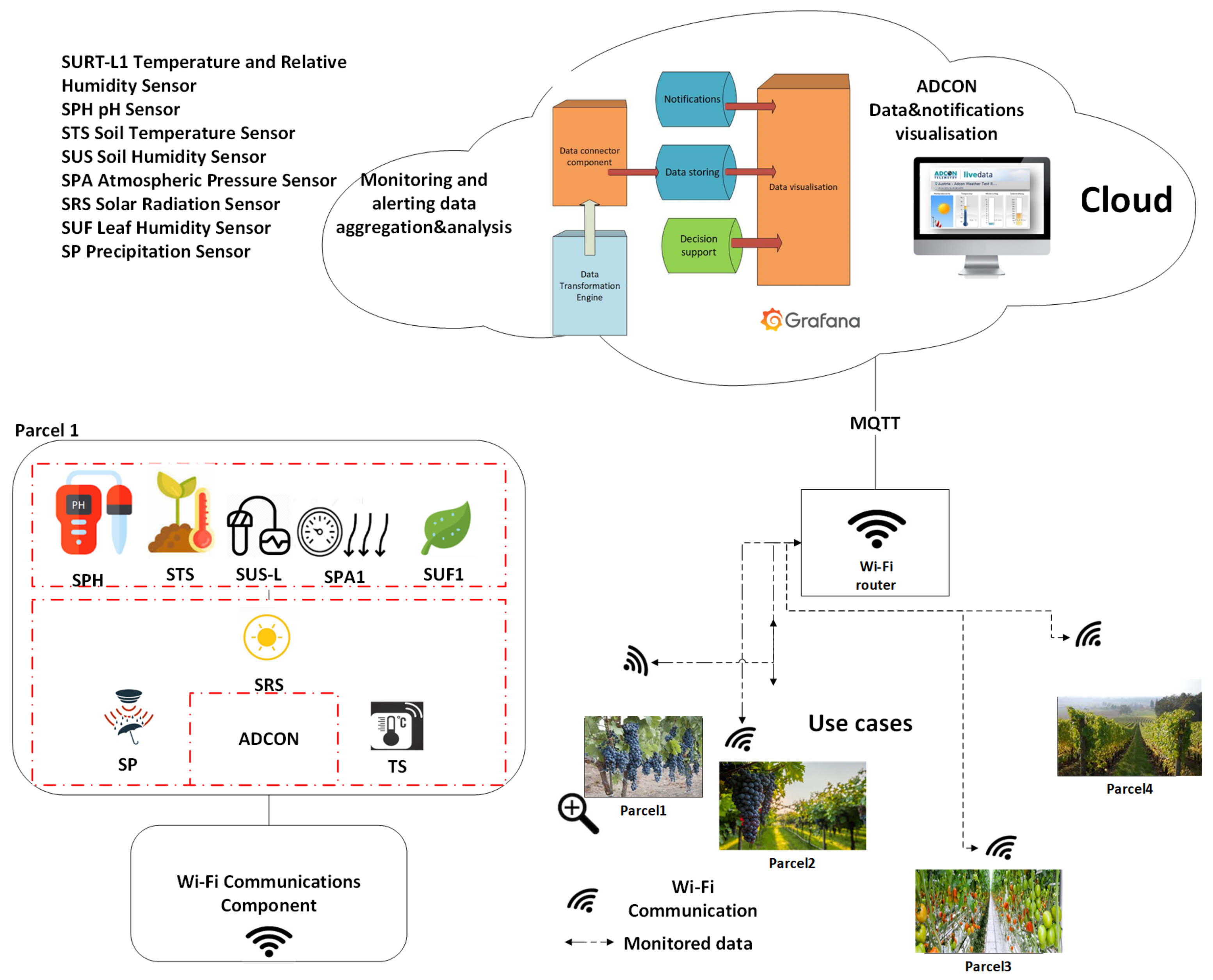Predictive Analysis and Wine-Grapes Disease Risk Assessment Based on Atmospheric Parameters and Precision Agriculture Platform
Abstract
1. Introduction
2. Materials and Methods
2.1. Precision Agriculture Platform
2.2. Sensing Devices
2.3. Monitored Data, Methodology, and Statistics
2.3.1. Methodology for Air Temperature Data
- Collect air temperature data.
- Analyze the air temperature time series and eliminate the outliers based on the air temperature data range in Table 1.
- Compute the daily amount of heat (DAH) [42] based on Equation (1):where is the maximum temperature in a day, is the minimum temperature in the same day, and is the base temperature. is the threshold temperature below which the plant stops developing. According to [43], the study using four grapevine categories and three different evaluation methods, it was predicted that for grapes should be 10 °C (as mentioned in Table 2).
- Considering that crop’s development is influenced by the thermal environment (temperature/heat) and that the resulting relationship typically follows a sigmoid or S-shaped curve [44], determine the parameters A, B, , and of the sigmoid curve given by Equation (3) [45] best fitting the CAH for the air temperature time series in the specific season.
2.3.2. Methodology for Precipitation Data
- Collect precipitations and ET data (based on solar radiation inputs) for each season.
- Analyze the precipitations time series and eliminate the outliers based on the precipitation data range in Table 1.
- Analyze the precipitation–ET balance.
- Determine precipitation autocorrelation for each season.
2.3.3. Methodology for Crop Diseases Estimation
3. Results and Discussion
3.1. Predictions on Atmospheric Parameters
3.1.1. Cumulative Amount of Heat (CAH)
3.1.2. The Amount of Heat Received Daily
3.1.3. Precipitation
3.1.4. Phenological Calendar
3.2. Crop Diseases Estimation
3.2.1. Powdery Mildew
3.2.2. Grape Bunch Rot
3.2.3. Grape Downy Mildew
3.3. Discussion of Experimental Results
4. Conclusions
Author Contributions
Funding
Institutional Review Board Statement
Informed Consent Statement
Data Availability Statement
Conflicts of Interest
Abbreviations
| CAH | Cumulative amount of heat |
| DAH | Daily amount of heat |
| DC | Degree-days Celsius |
| ET | Evapotranspiration |
| GDD | Growing degree day |
| GDM | Grape downy mildew |
| IoT | Internet of Things |
| ML | Machine learning |
| MQTT | Message Queueing Telemetry Transport |
| PAR | Photosynthetically active radiation |
| RMSE | Root mean squared error |
| WSNs | Wireless sensor networks |
References
- Mallarino, A. Available online: https://crops.extension.iastate.edu/encyclopedia/using-precision-agriculture-improve-soil-fertility-management-and-farm-research (accessed on 19 November 2021).
- Orsini, R.; Fiorentini, M.; Zenobi, S. Evaluation of Soil Management Effect on Crop Productivity and Vegetation Indices Accuracy in Mediterranean Cereal-Based Cropping Systems. Sensors 2020, 20, 3383. [Google Scholar] [CrossRef] [PubMed]
- Techen, A.K.; Helming, K.; Brüggemann, N.; Veldkamp, E.; Reinhold-Hurek, B.; Lorenz, M.; Bartke, S.; Heinrich, U.; Amelung, W.; Augustin, K.; et al. Chapter Four—Soil research challenges in response to emerging agricultural soil management practices. In Advances in Agronomy; Academic Press: Cambridge, MA, USA, 2020; Volume 161, pp. 179–240. [Google Scholar] [CrossRef]
- Vrindts, E.; Reyniers, M.; Darius, P.; De baerdemaeker, J.; Gilot, M.; Sadaoui, Y.; Frankinet, M.; Hanquet, B.; Destain, M.F. Analysis of Soil and Crop Properties for Precision Agriculture for Winter Wheat. Biosyst. Eng. 2003, 85, 141–152. [Google Scholar] [CrossRef]
- Tropical Rust. Available online: https://plantix.net/en/library/plant-diseases/100101/tropical-rust (accessed on 24 November 2021).
- Marta, A.D.; Stefano, V.D.; Cerovic, Z.G.; Agati, G.; Orlandini, S. Solar radiation affects grapevine susceptibility to Plasmopara Viticola. Sci. Agric. 2008, 65, 65–70. [Google Scholar] [CrossRef]
- Ishimaru, T.; Sasaki, K.; Nozaki, I.; Ichihashi, M.; Shimizu, H.; Wakayama, M.; Hirabayashi, H. Effect of the light and dark conditions on flower opening time between cultivated rice (Oryza Sativa) A Near-Isogenic Early-Morning Flower Line. AoB Plants 2021, 13, plab040. [Google Scholar] [CrossRef] [PubMed]
- Young, H.M.; George, S.; Narváez, D.F.; Srivastava, P.; Schuerger, A.C.; Wright, D.L.; Marois, J.J. Effect of Solar Radiation on Severity of Soybean Rust. Phytopathology 2012, 102, 794–803. [Google Scholar] [CrossRef] [PubMed][Green Version]
- Rabbi, B.; Chen, Z.H.; Sethuvenkatraman, S. Protected Cropping in Warm Climates: A Review of Humidity Control and Cooling Methods. Energies 2019, 12, 2737. [Google Scholar] [CrossRef]
- Campillo, C.; Fortes, R.; del Henar Prieto, M. Solar Radiation Effect on Crop Production. In Solar Radiation; InTech: New York, NY, USA, 2012. [Google Scholar] [CrossRef]
- Mohandass, D.; Zhao, J.L.; Xia, Y.M.; Campbell, M.J.; Li, Q.J. Increasing temperature causes flowering onset time changes of alpine ginger Roscoea in the Central Himalayas. J. Asia-Pac. Biodivers. 2015, 8, 191–198. [Google Scholar] [CrossRef]
- Manavalan, R. Efficient Detection of Sugarcane Diseases through Intelligent Approaches: A Review. Asian J. Res. Rev. Agric. 2021, 3, 27–37. [Google Scholar]
- Velásquez, A.C.; Castroverde, C.D.M.; He, S.Y. Plant–Pathogen Warfare under Changing Climate Conditions. Curr. Biol. 2018, 28, R619–R634. [Google Scholar] [CrossRef]
- Venios, X.; Korkas, E.; Nisiotou, A.; Banilas, G. Grapevine Responses to Heat Stress and Global Warming. Plants 2020, 9, 1754. [Google Scholar] [CrossRef]
- Vegetation Influence on Precipitation. Available online: https://forestrypedia.com/vegetation-influence-on-precipitation/ (accessed on 19 December 2021).
- Heuvel, J.V.; Centinari, M. Under-Vine Vegetation Mitigates the Impacts of Excessive Precipitation in Vineyards. Front. Plant Sci. 2021, 12, 1542. [Google Scholar] [CrossRef]
- Hazelrigg, A.L.; Bradshaw, T.L.; Maia, G.S. Disease Susceptibility of Interspecific Cold-Hardy Grape Cultivars in Northeastern U.S.A. Horticulturae 2021, 7, 216. [Google Scholar] [CrossRef]
- Du, F.; Deng, W.; Yang, M.; Wang, H.; Mao, R.; Shao, J.; Fan, J.; Chen, Y.; Fu, Y.; Li, C.; et al. Protecting grapevines from rainfall in rainy conditions reduces disease severity and enhances profitability. Crop Prot. 2015, 67, 261–268. [Google Scholar] [CrossRef]
- 7 Most Common Grapevine Diseases. Available online: https://learn.winecoolerdirect.com/common-grapevine-diseases/ (accessed on 19 December 2021).
- Yang, C. Remote Sensing and Precision Agriculture Technologies for Crop Disease Detection and Management with a Practical Application Example. Engineering 2020, 6, 528–532. [Google Scholar] [CrossRef]
- Bischoff, V.; Farias, K.; Menzen, J.P.; Pessin, G. Technological support for detection and prediction of plant diseases: A systematic mapping study. Comput. Electron. Agric. 2021, 181, 105922. [Google Scholar] [CrossRef]
- The Digitisation of the European Agricultural Sector. Available online: https://digital-strategy.ec.europa.eu/en/policies/digitisation-agriculture (accessed on 19 November 2021).
- Zervopoulos, A.; Tsipis, A.; Alvanou, A.G.; Bezas, K.; Papamichail, A.; Vergis, S.; Stylidou, A.; Tsoumanis, G.; Komianos, V.; Koufoudakis, G.; et al. Wireless Sensor Network Synchronization for Precision Agriculture Applications. Agriculture 2020, 10, 89. [Google Scholar] [CrossRef]
- Balaceanu, C.M.; Marcu, I.; Suciu, G. Telemetry System for Smart Agriculture. In Business Information Systems Workshops; Springer International Publishing: Cham, Switzerland, 2019; pp. 573–584. [Google Scholar] [CrossRef]
- Lu, W.; Xu, X.; Huang, G.; Li, B.; Wu, Y.; Zhao, N.; Yu, F.R. Energy Efficiency Optimization in SWIPT Enabled WSNs for Smart Agriculture. IEEE Trans. Ind. Inform. 2021, 17, 4335–4344. [Google Scholar] [CrossRef]
- Suciu, G.; Marcu, I.; Balaceanu, C.; Dobrea, M.; Botezat, E. Efficient IoT system for Precision Agriculture. In Proceedings of the 2019 15th International Conference on Engineering of Modern Electric Systems (EMES), Oradea, Romania, 13–14 June 2019; pp. 173–176. [Google Scholar] [CrossRef]
- Visconti, P.; de Fazio, R.; Velázquez, R.; Del-Valle-Soto, C.; Giannoccaro, N.I. Development of Sensors-Based Agri-Food Traceability System Remotely Managed by a Software Platform for Optimized Farm Management. Sensors 2020, 20, 3632. [Google Scholar] [CrossRef]
- Food and Agriculture Organization of the United Nations. Approaches Used to Investigate the Effects of Climate Change on Plant Pests. Available online: https://www.fao.org/3/cb4769en/online/src/html/approaches-used-to-investigate-the-effects-of-climate-change-on-plant-pests.html (accessed on 14 January 2022).
- Zayan, S.A. Impact of Climate Change on Plant Diseases and IPM Strategies. In Plant Diseases—Current Threats and Management Trends; IntechOpen: New York, NY, USA, 2020. [Google Scholar] [CrossRef]
- Wang, X.; Liu, J.; Zhu, X. Early real-time detection algorithm of tomato diseases and pests in the natural environment. Plant Methods 2021, 17, 43. [Google Scholar] [CrossRef]
- Newlands, N.K. Model-Based Forecasting of Agricultural Crop Disease Risk at the Regional Scale, Integrating Airborne Inoculum, Environmental, and Satellite-Based Monitoring Data. Front. Environ. Sci. 2018, 6, 63. [Google Scholar] [CrossRef]
- Ravindra, S. IoT Applications in Agriculture. Available online: https://www.iotforall.com/iot-applications-in-agriculture (accessed on 19 December 2021).
- Akhtar, M.N.; Shaikh, A.J.; Khan, A.; Awais, H.; Bakar, E.A.; Othman, A.R. Smart Sensing with Edge Computing in Precision Agriculture for Soil Assessment and Heavy Metal Monitoring: A Review. Agriculture 2021, 11, 475. [Google Scholar] [CrossRef]
- Bu, F.; Wang, X. A smart agriculture IoT system based on deep reinforcement learning. Future Gener. Comput. Syst. 2019, 99, 500–507. [Google Scholar] [CrossRef]
- Haseeb, K.; Din, I.U.; Almogren, A.; Islam, N. An Energy Efficient and Secure IoT-Based WSN Framework: An Application to Smart Agriculture. Sensors 2020, 20, 2081. [Google Scholar] [CrossRef] [PubMed]
- Thakur, D.; Kumar, Y.; Kumar, A.; Singh, P.K. Applicability of Wireless Sensor Networks in Precision Agriculture: A Review. Wirel. Pers. Commun. 2019, 107, 471–512. [Google Scholar] [CrossRef]
- Marcu, I.M.; Suciu, G.; Balaceanu, C.M.; Banaru, A. IoT based System for Smart Agriculture. In Proceedings of the 2019 11th International Conference on Electronics, Computers and Artificial Intelligence (ECAI), Pitesti, Romania, 27–29 June 2019. [Google Scholar] [CrossRef]
- Grafana Labs. Grafana: The Open Observability Platform. Available online: https://grafana.com/ (accessed on 12 December 2021).
- ADCON. ADCON addVANTAGE 6.x. Available online: https://www.adcon.com/products/software-285/adcon-addvantage-6x-1485/ (accessed on 10 September 2021).
- ADCON. Sensors. Available online: https://www.adcon.com/products/sensors-284/ (accessed on 10 September 2021).
- ADCON. Available online: https://www.adcon.com/download/leaflet-tr1-temperature-humididy-sensor/ (accessed on 19 June 2021).
- Alonso, F.; Chiamolera, F.M.; Hueso, J.J.; González, M.; Cuevas, J. Heat Unit Requirements of “Flame Seedless” Table Grape: A Tool to Predict Its Harvest Period in Protected Cultivation. Plants 2021, 10, 904. [Google Scholar] [CrossRef]
- Zapata, D.; Salazar, M.; Chaves, B.; Keller, M.; Hoogenboom, G. Estimation of the base temperature and growth phase duration in terms of thermal time for four grapevine cultivars. Int. J. Biometeorol. 2015, 59, 1771–1781. [Google Scholar] [CrossRef]
- Brown, P. Heat Units. Available online: https://cals.arizona.edu/crop/cotton/cropmgt/az1602.pdf (accessed on 20 December 2021).
- Lespinard, A.R.; Salgado, P.R.; Mascheroni, R.H. Sigmoid Model: Application to Heat Transfer in Vegetable Preserves Sterilized in Glass Jars. Lat. Am. Appl. Res. 2008, 38, 273–278. [Google Scholar]
- de Medeiros, G.A.; Daniel, L.A.; Fengler, F.H. Growth, Development, and Water Consumption of Irrigated Bean Crop Related to Growing Degree-Days on Different Soil Tillage Systems in Southeast Brazil. Int. J. Agron. 2016, 2016, 1–7. [Google Scholar] [CrossRef]
- Parthasarathi, T.; Velu, G.; Jeyakumar, P. Impact of Crop Heat Units on Growth and Developmental Physiology of Future Crop Production: A Review. Res. Rev. J. Crop Sci. Technol. 2013, 2, 2319–3395. [Google Scholar]
- Urska. Why the Need to Calculate Growing Degree Days in Vineyard? Available online: https://www.evineyardapp.com/blog/2017/03/01/why-the-need-to-calculate-growing-degree-days-in-vineyard/ (accessed on 19 December 2021).
- Oliver, S.T.; González-Pérez, A.; Guijarro, J.H. Adapting Models to Warn Fungal Diseases in Vineyards Using In-Field Internet of Things (IoT) Nodes. Sustainability 2019, 11, 416. [Google Scholar] [CrossRef]
- VitiSolutions. Development of Regional IPM Best Practice. Available online: https://www.wineaustralia.com/getmedia/30ce63d5-57fb-4a65-a618-a9b711f6b546/VTS-06-01-Final-Report (accessed on 21 November 2021).
- de Oliveira, A.F.; Serra, S.; Ligios, V.; Satta, D.; Nieddu, G. Assessing the Effects of Vineyard Soil Management on Downy and Powdery Mildew Development. Horticulturae 2021, 7, 209. [Google Scholar] [CrossRef]
- Jaspers, M.V.; Seyb, A.M.; Trought, M.C.T.; Balasubramaniam, R. Overwintering grapevine debris as an important source of Botrytis cinerea inoculum. Plant Pathol. 2013, 62, 130–138. [Google Scholar] [CrossRef]
- Shah, N.G.; Desai, U.B.; Das, I.; Merchant, S.N.; Yadav, S.S. In-field wireless sensor network (WSN) for estimating evapotranspiration and leaf wetness. Int. Agric. Eng. J. 2009, 18, 43–51. [Google Scholar]
- Coertze, S.; Holz, G.; Sadie, A. Germination and Establishment of Infection on Grape Berries by Single Airborne Conidia of Botrytis Cinerea. Plant Dis. 2001, 85, 668–677. [Google Scholar] [CrossRef]
- PRISME Consortium. Available online: https://ipmsymposium.org/2021/Documents/PRISMECosortium.pdf (accessed on 20 June 2022).
- Pertot, I.; Caffi, T.; Rossi, V.; Mugnai, L.; Hoffmann, C.; Grando, M.; Gary, C.; Lafond, D.; Duso, C.; Thiery, D.; et al. A critical review of plant protection tools for reducing pesticide use on grapevine and new perspectives for the implementation of IPM in viticulture. Crop Prot. 2017, 97, 70–84. [Google Scholar] [CrossRef]
- Van Leeuwen, C.; Garnier, C.; Agut, C.; Baculat, B.; Barbeau, G.; Besnard, E.; Bois, B.; Boursiquot, J.M.; Chuine, I.; Dessup, T.; et al. Heat requirements for grapevine varieties is essential information to adapt plant material in a changing climate. In Proceedings of the 2008 VIIth International terroir Congress, Agroscope Changins-Wädenswil, Nyon, Switzerland, 19–23 May 2008. [Google Scholar]
- Droulia, F.; Charalampopoulos, I. A Review on the Observed Climate Change in Europe and Its Impacts on Viticulture. Atmosphere 2022, 13, 837. [Google Scholar] [CrossRef]
- Martínez-Lüscher, J.; Chen, C.C.L.; Brillante, L.; Kurtural, S.K. Mitigating Heat Wave and Exposure Damage to “Cabernet Sauvignon” Wine Grape With Partial Shading Under Two Irrigation Amounts. Front. Plant Sci. 2020, 11, 579192. [Google Scholar] [CrossRef]
- Ohba, M. Precipitation under climate change. In Precipitation; Elsevier: Amsterdam, The Netherlands, 2021; pp. 21–51. [Google Scholar] [CrossRef]
- Caian, M.; Georgescu, F.; Dobre, A.; Neague, P. Variability of Precipitation in Romania: Recent Trends and Projected Changes in Climate Scenarios. WeADL 2021 Workshop. 2021. Available online: http://www.cs.ubbcluj.ro/weadl/wp-content/uploads/2022/06/Mihaela%20Caian%20-%20Variability%20of%20precipitation%20in%20Romania.pdf (accessed on 18 January 2022).
- EIP-AGRI Focus Group. Diseases and Pests in Viticulture. Available online: https://ec.europa.eu/eip/agriculture/sites/default/files/eip-agri_fg_diseases_and_pests_in_viticulture_final_report_2019_en.pdf (accessed on 8 July 2022).
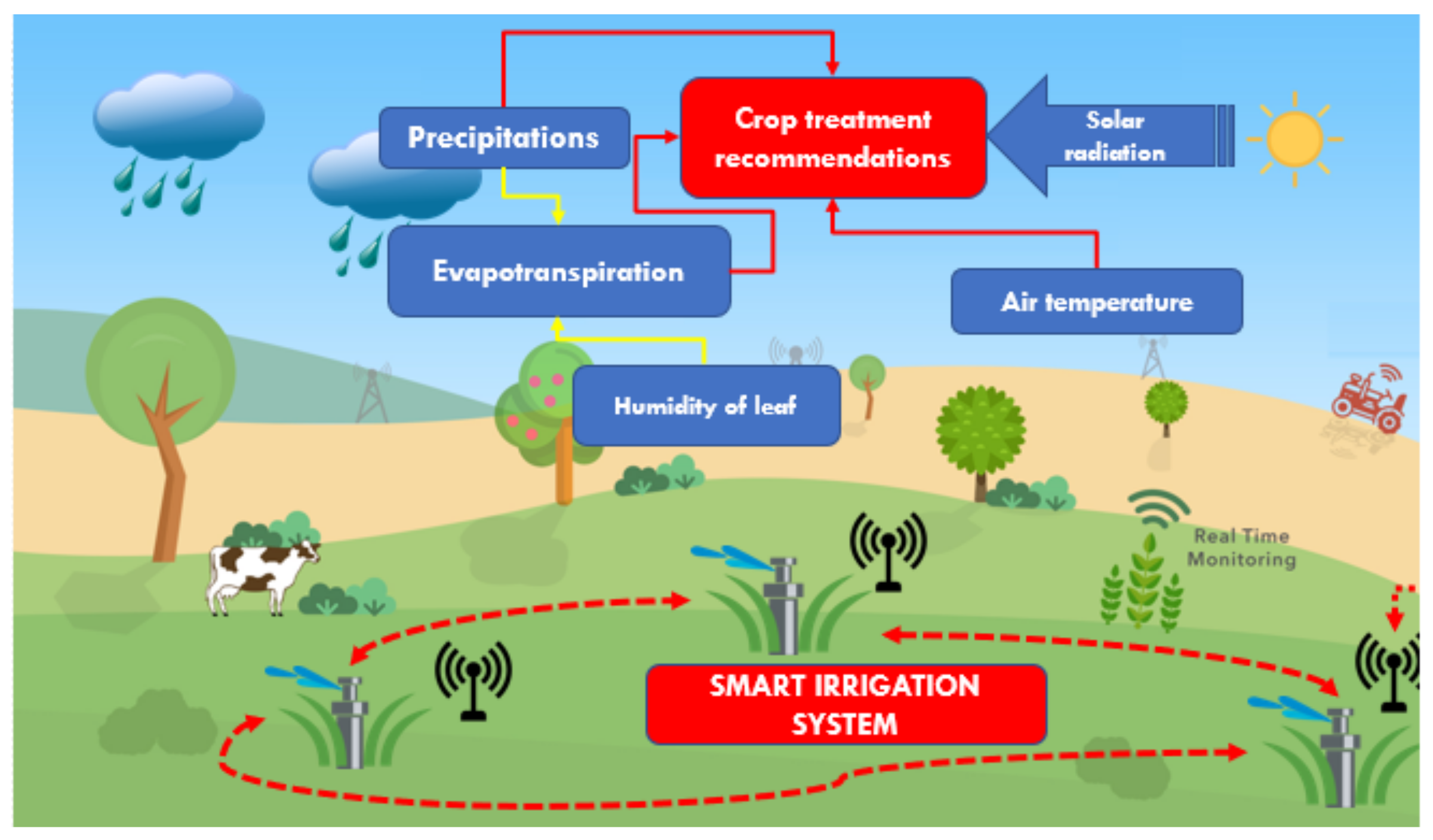
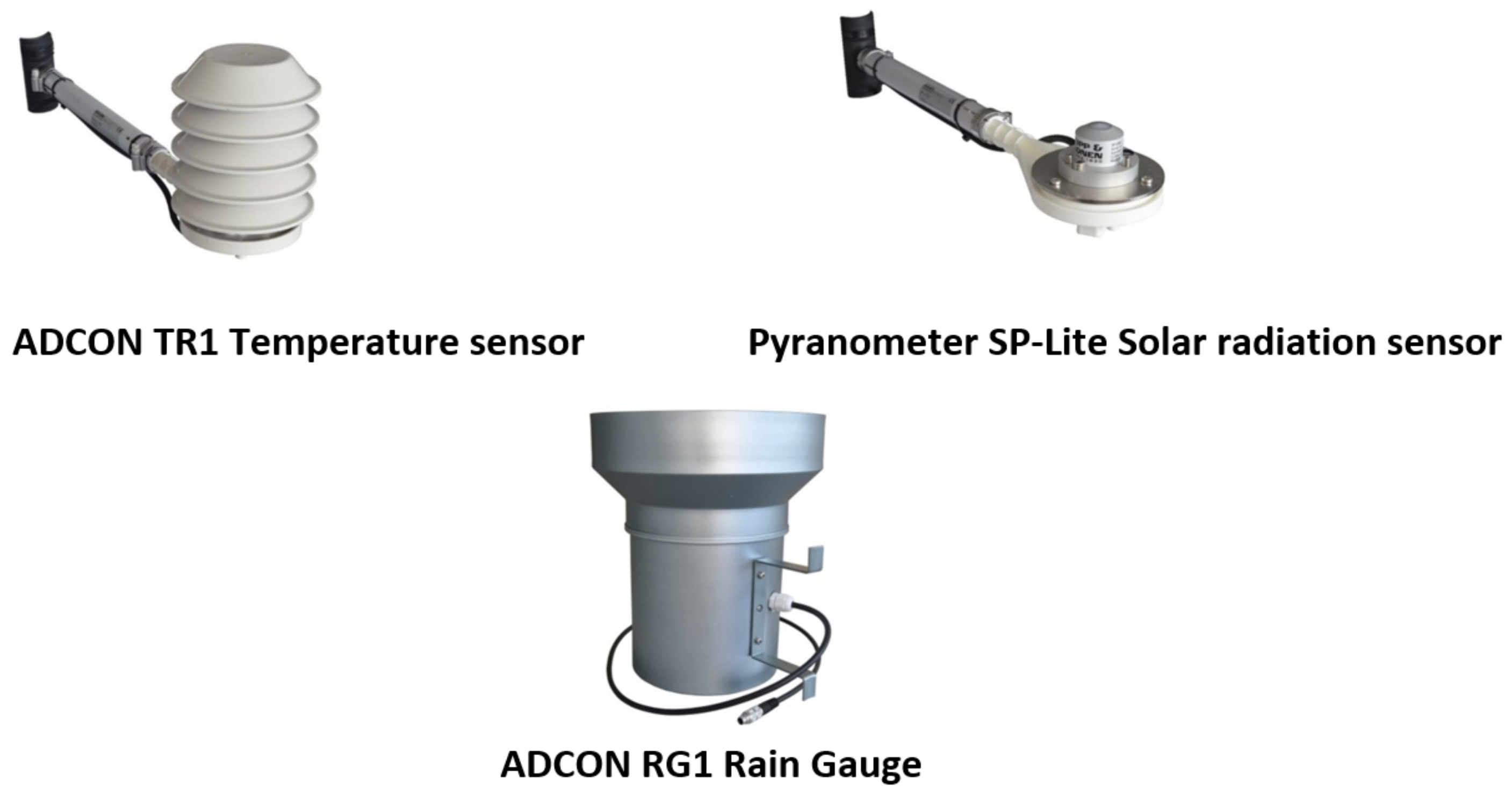

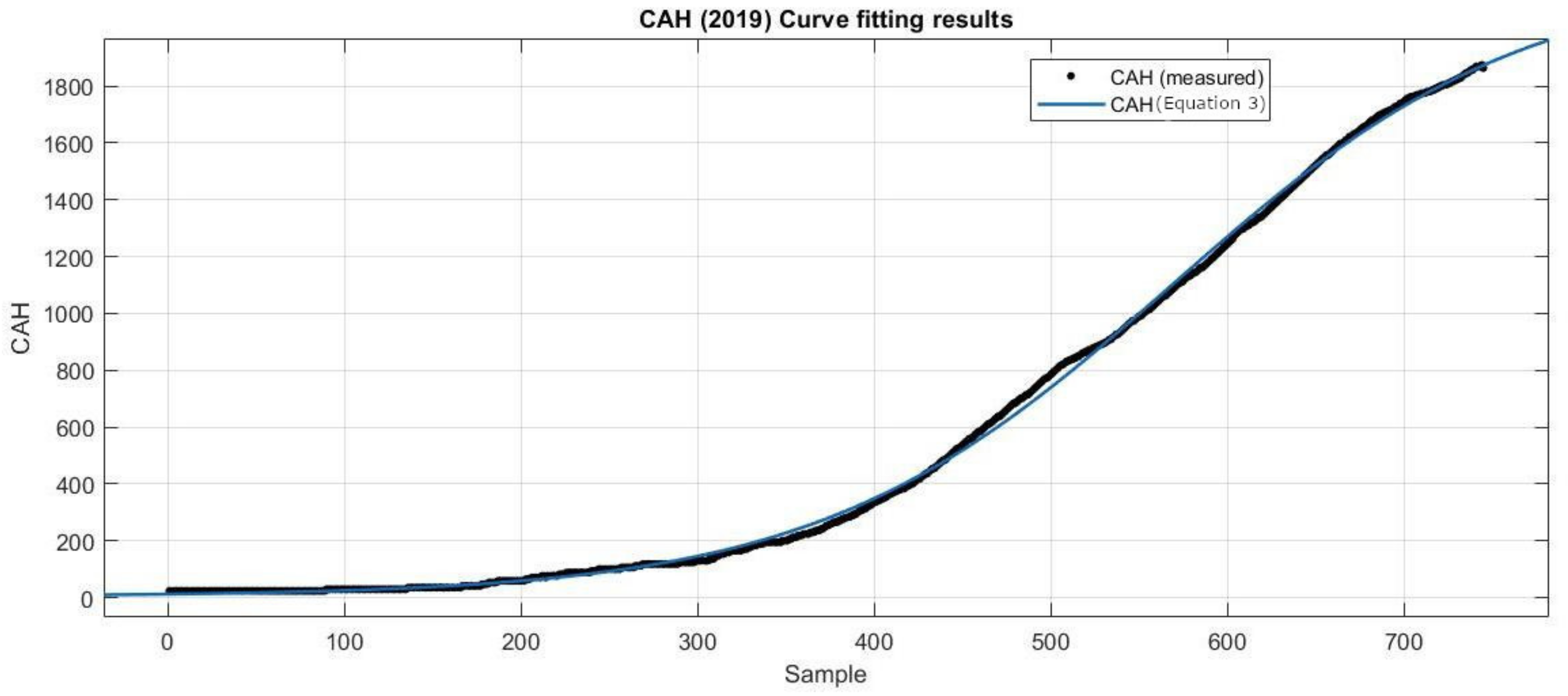
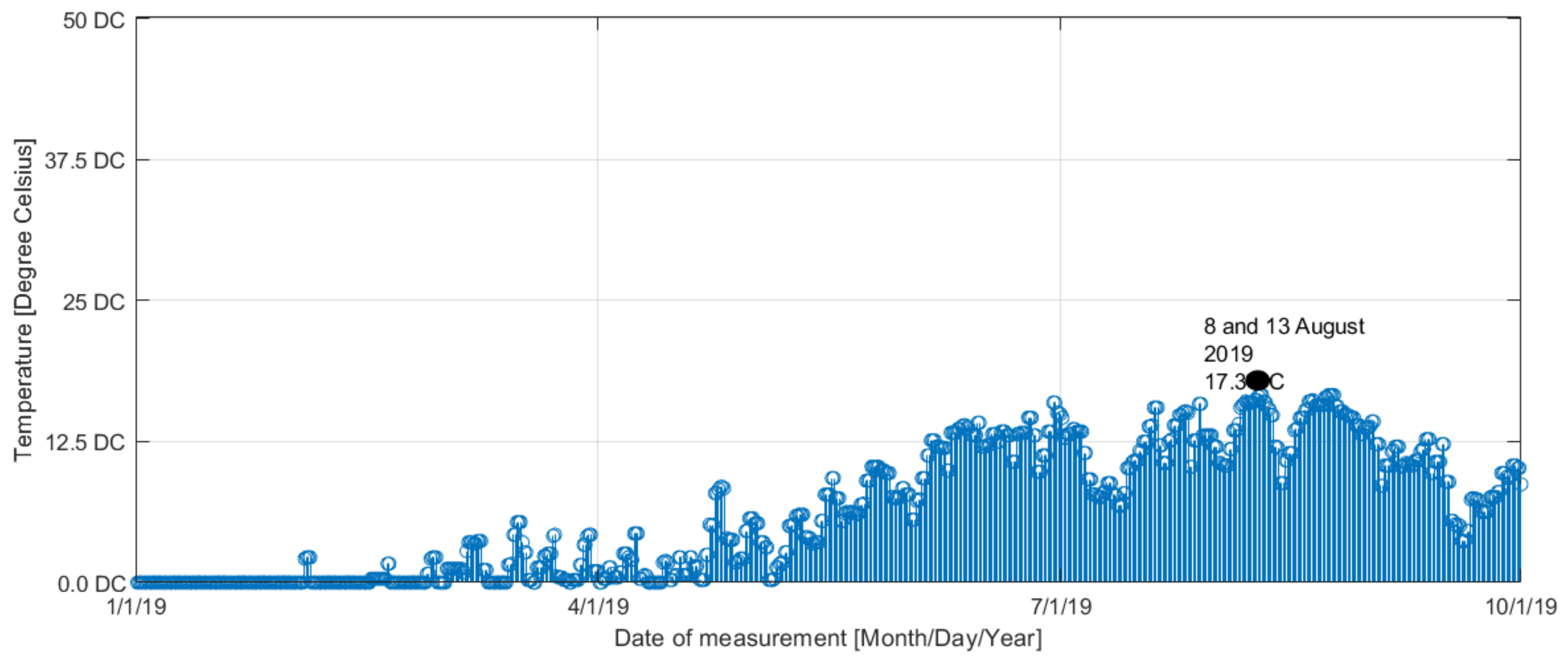
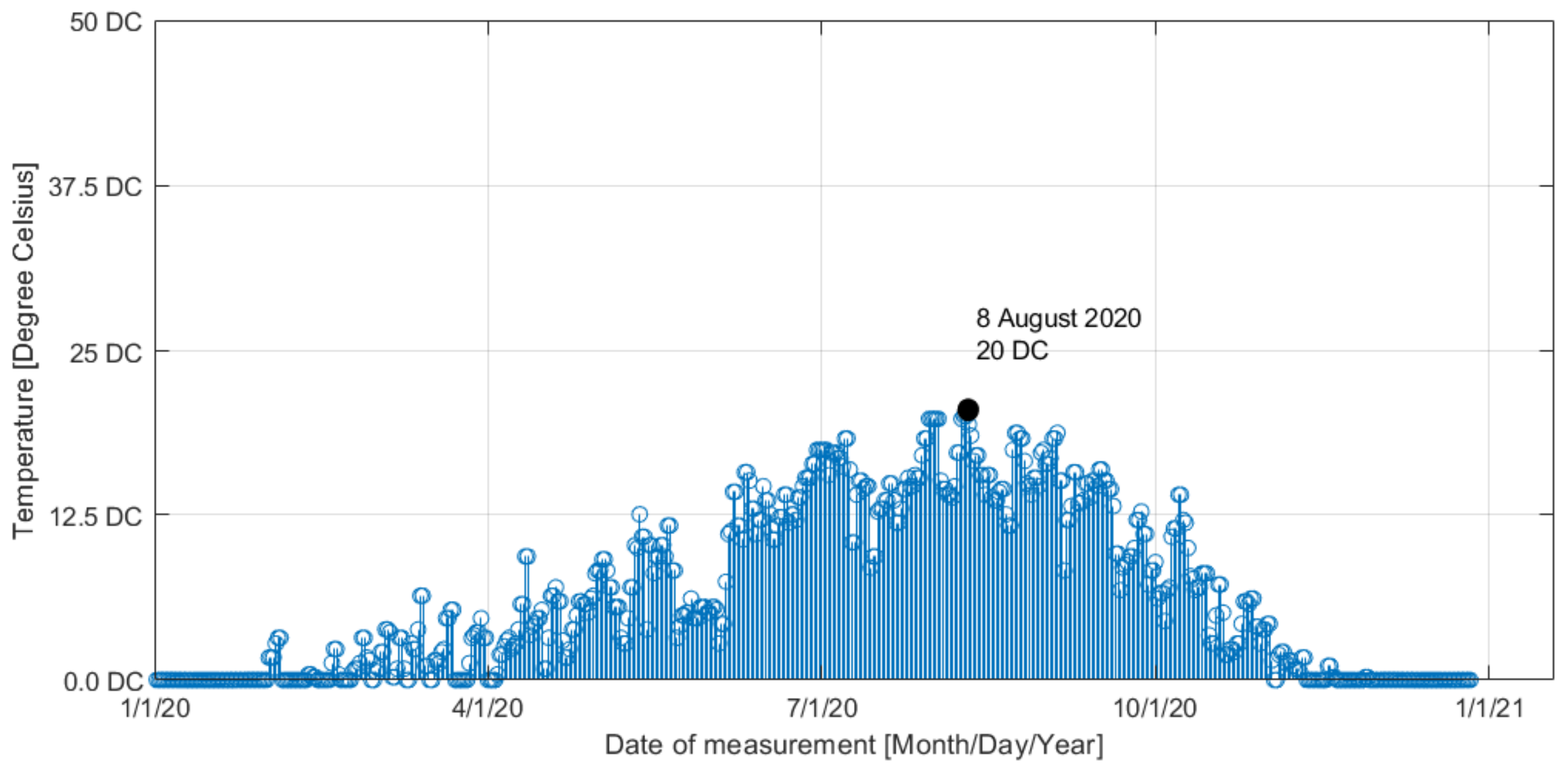
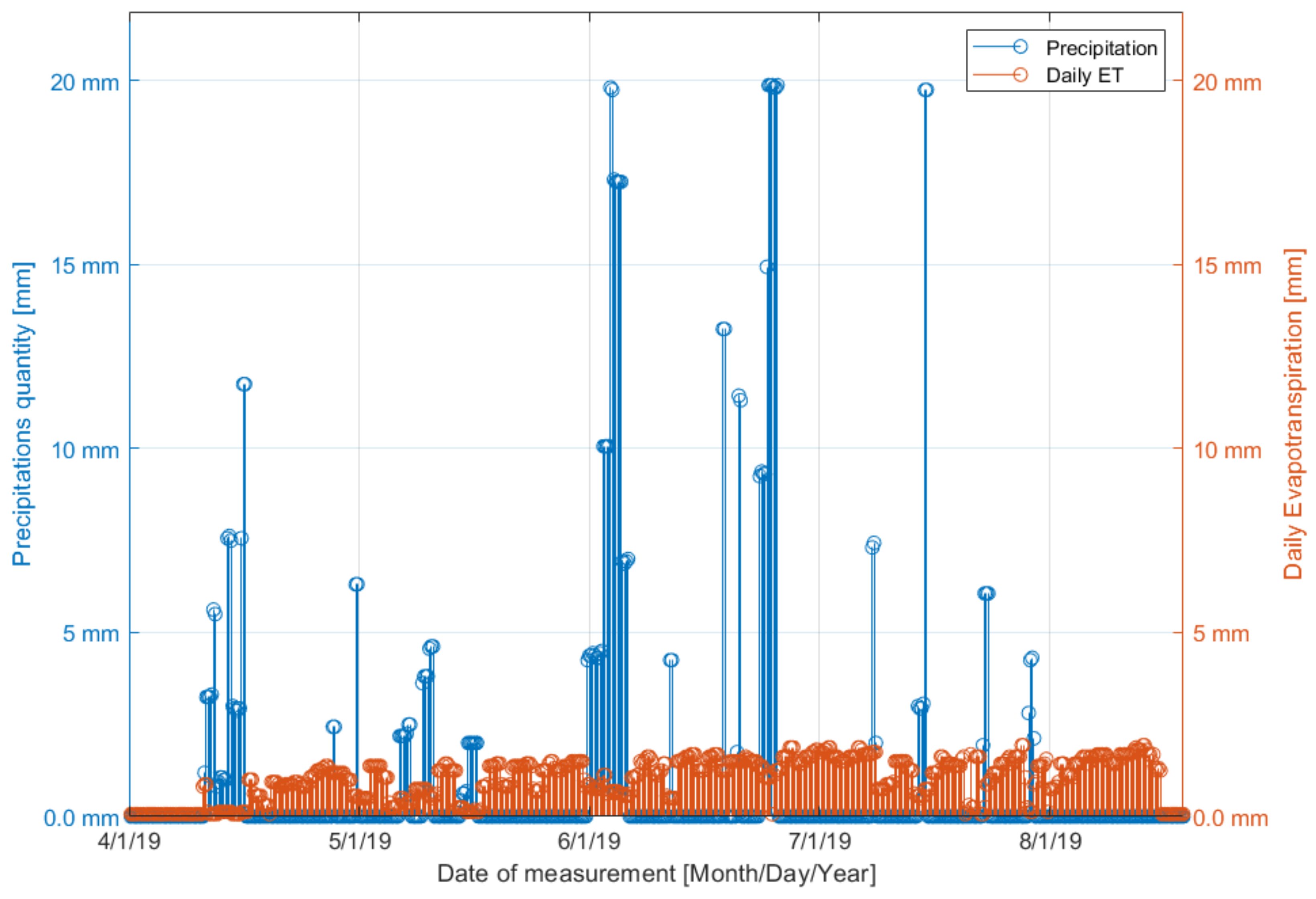



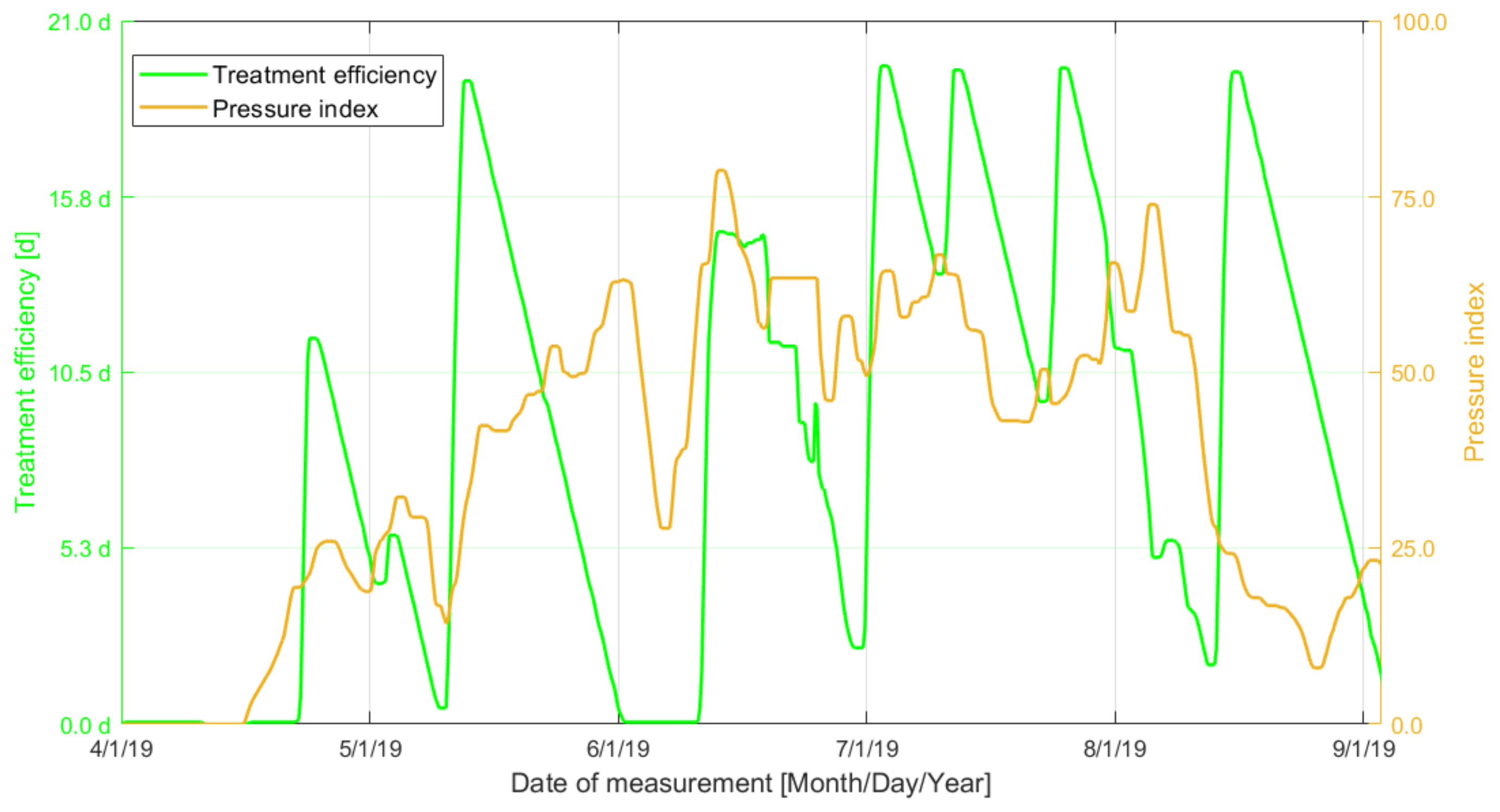
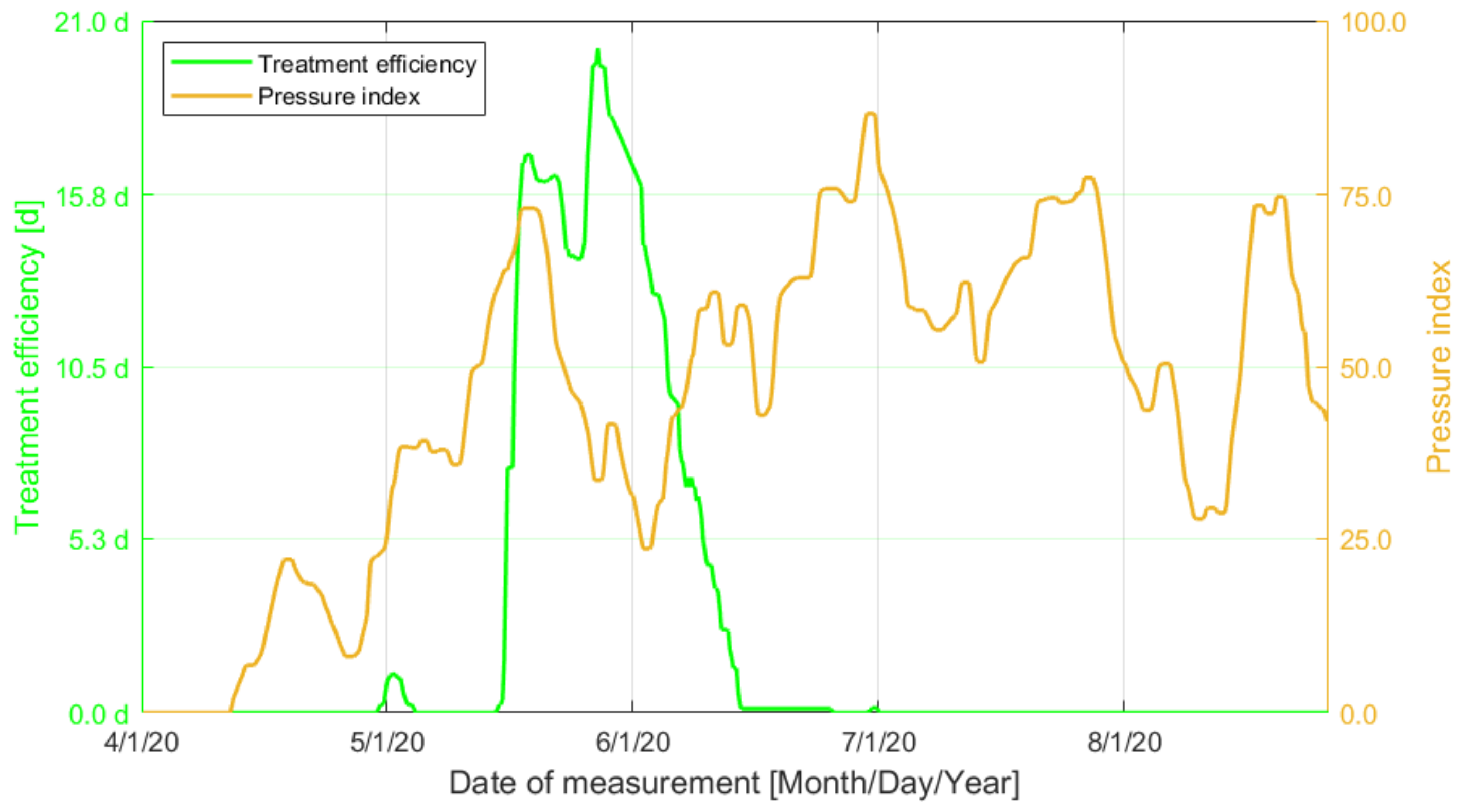
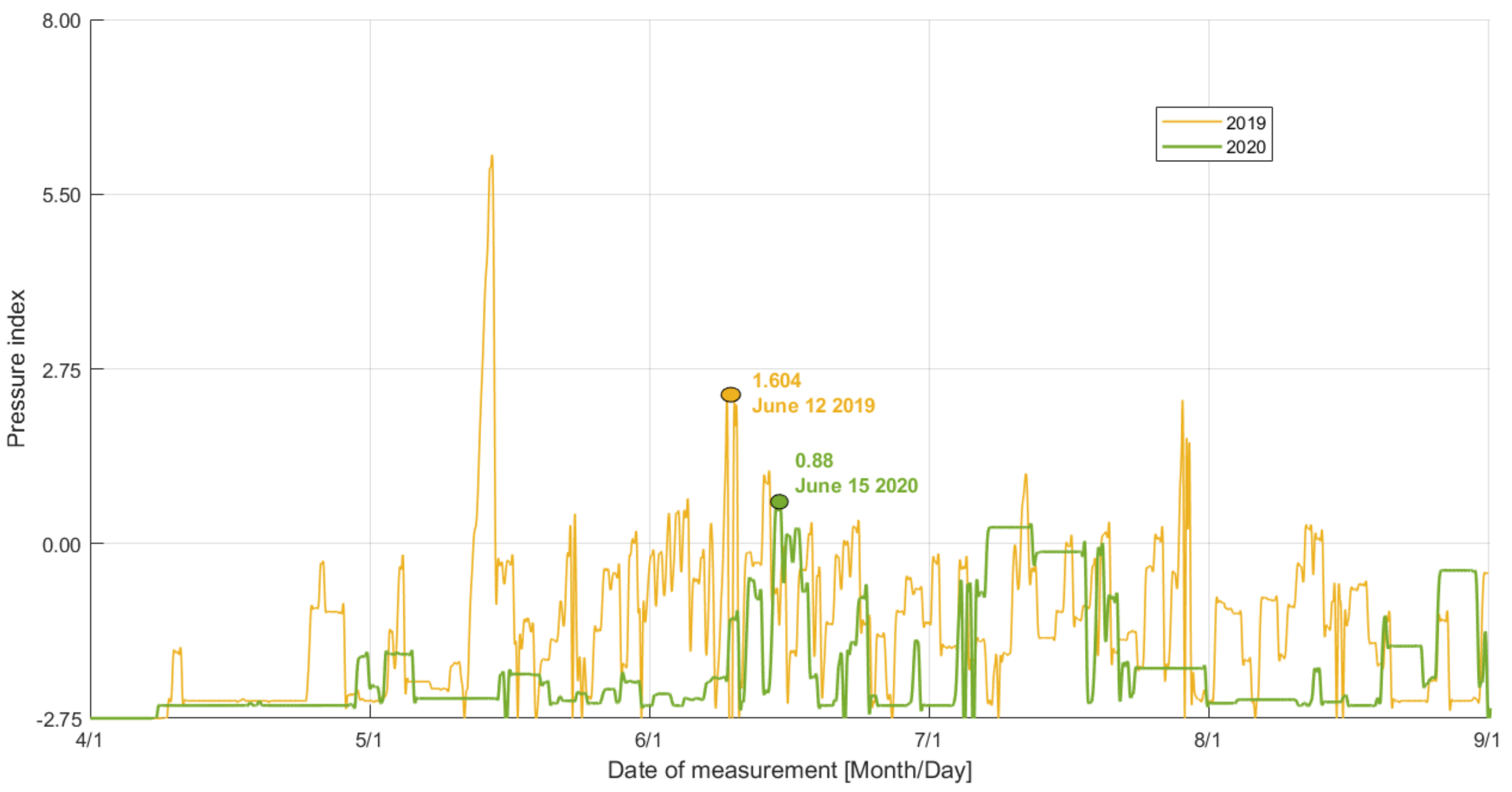
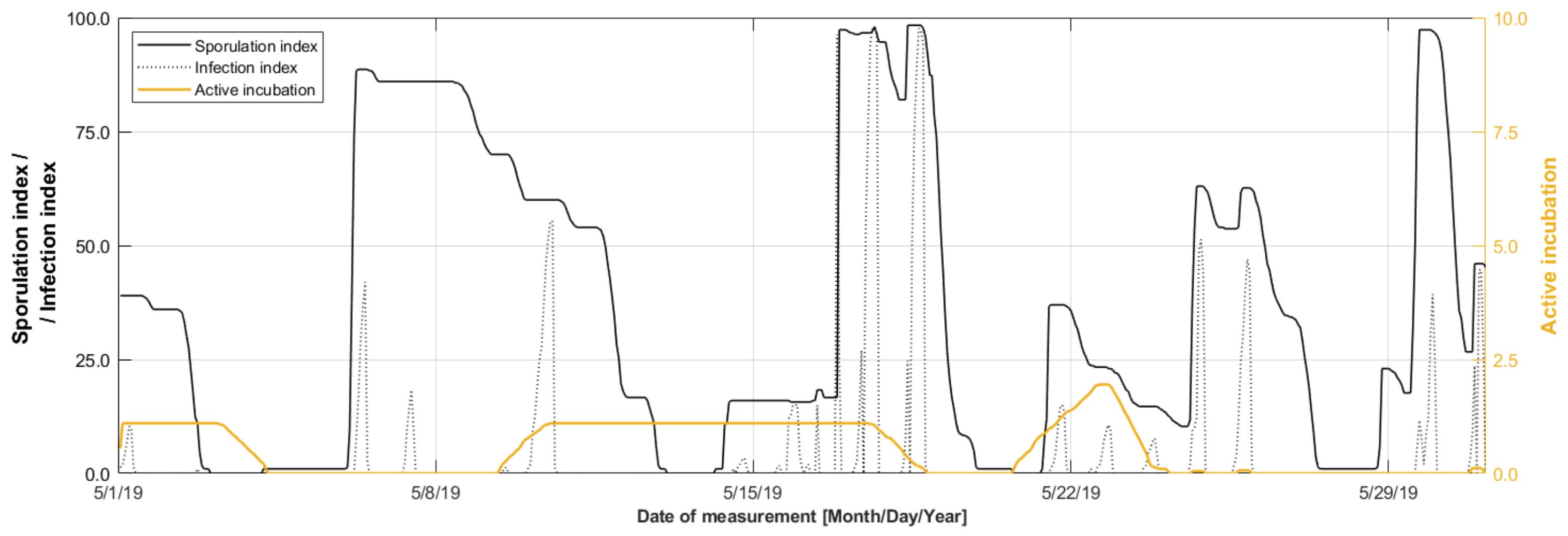
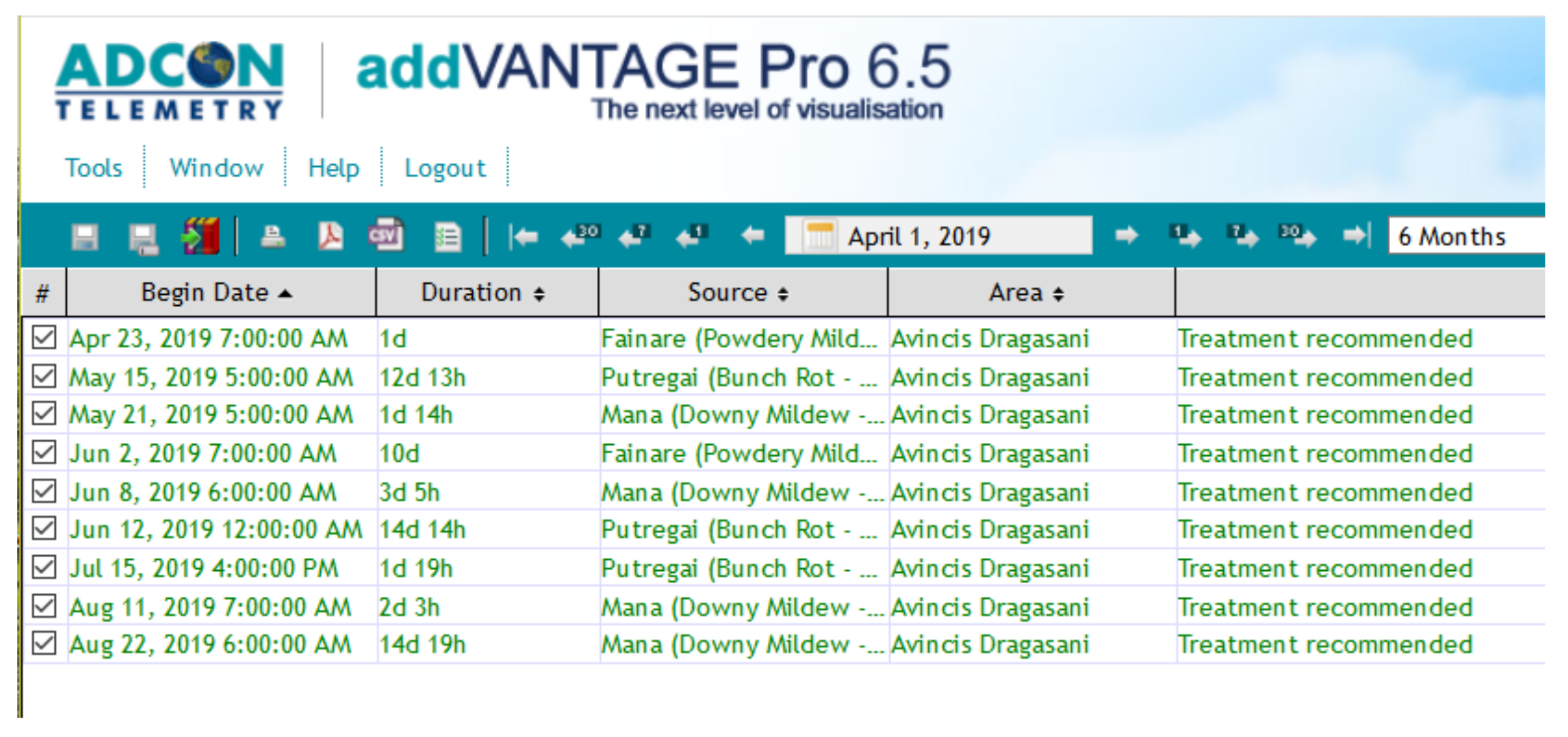
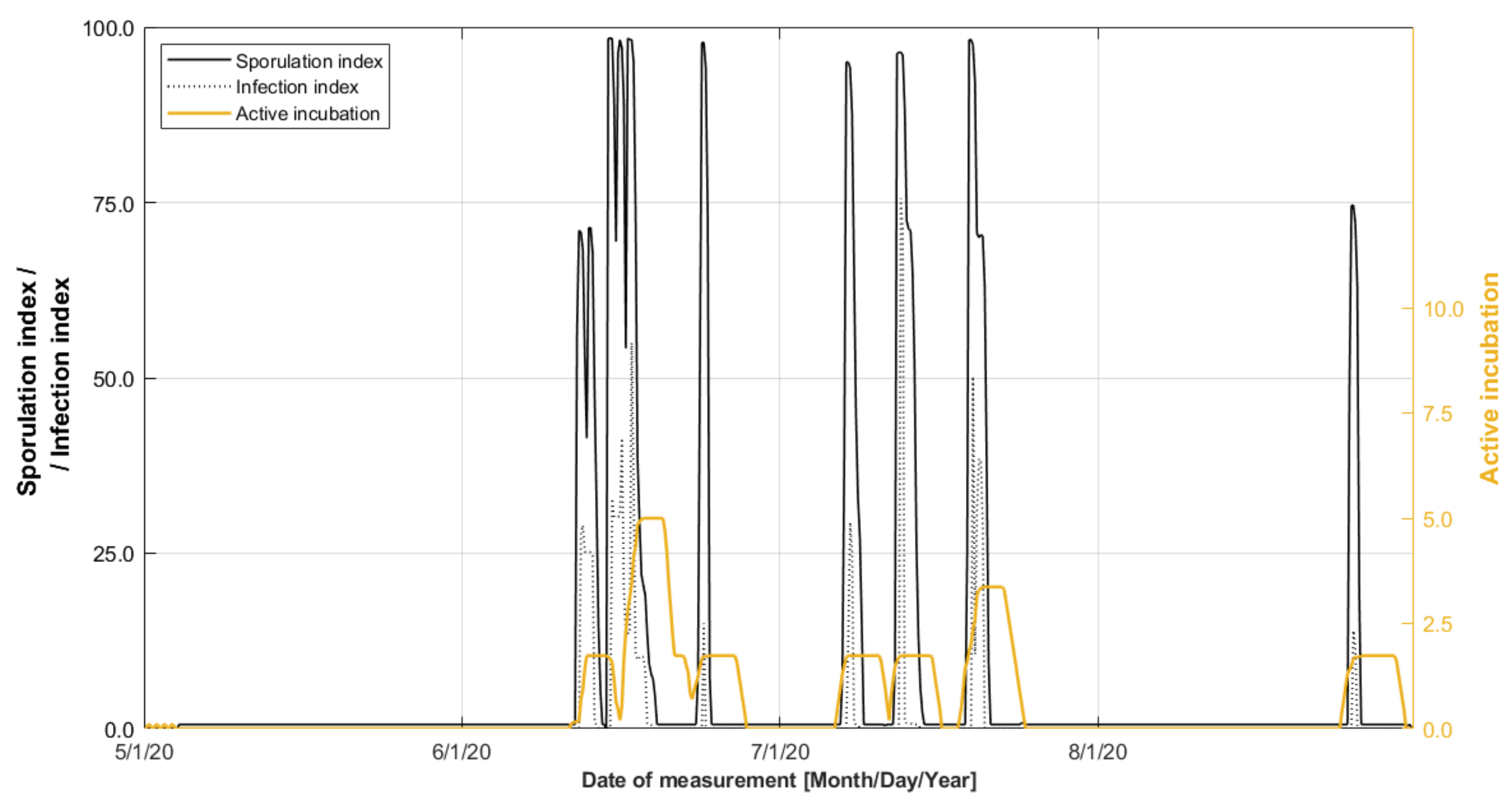
| Sensor | Parameter | Sensing Element/ Measuring Principle | Range | Accuracy/ Sensitivity |
|---|---|---|---|---|
| ADCON TR1 | Air temperature | pt1000 DIN A | −40 °C … +60 °C
−40 °F … +140 °F | Acc.: ±0.1 °C at 20 °C |
| ADCON RG1 Rain Gauge | Precipitations | Double tipping buckets | - | Acc.: up to 25 mm/h + 1%, up to 50 mm/h + 3% |
| Pyranometer SP-Lite | Solar radiation | Sensitive photodiode detector | Max. irradiance: 2000 W/m | Sens.: 75 µV/Wm |
| Values | Crops |
|---|---|
| 4.5 C | Wheat, barley, rye, oats, lettuce, asparagus. |
| 7.2 C | Sunflower, potatoes. |
| 10 C | Sweet corn, corn, rice, grapes, soybeans, tomatoes. |
| Ranges for Disease Pressure Index [%] | Disease Occurrence Risk |
|---|---|
| 0–30 | Light risk |
| 40–50 | Moderate risk |
| 0–100 | Severe risk |
| Ranges for Infection Index [%] | Disease Occurrence Risk |
|---|---|
| <0 | No risk |
| 0–50 | Low risk |
| 50–100 | Moderate risk |
| 100 | Severe risk |
| Parameter | Optimum Value | Range | ||
|---|---|---|---|---|
| 2019 | 2020 | 2019 | 2020 | |
| A | 4.695 | −0.9744 | (1.854, 7.536) | (−4.651, 2.703) |
| B | 2195 | 2152 | (2178, 2212) | (2146, 2157) |
| 568.6 | 510.2 | (566.9, 570.4) | (509.4, 511.1) | |
| 100.3 | 88.2 | (99.23, 101.4) | (87.41, 88.98) | |
| RMSE: 17.46 DC (2019) and RMSE: 24.85 DC (2020) | ||||
Publisher’s Note: MDPI stays neutral with regard to jurisdictional claims in published maps and institutional affiliations. |
© 2022 by the authors. Licensee MDPI, Basel, Switzerland. This article is an open access article distributed under the terms and conditions of the Creative Commons Attribution (CC BY) license (https://creativecommons.org/licenses/by/4.0/).
Share and Cite
Marcu, I.; Drăgulinescu, A.-M.; Oprea, C.; Suciu, G.; Bălăceanu, C. Predictive Analysis and Wine-Grapes Disease Risk Assessment Based on Atmospheric Parameters and Precision Agriculture Platform. Sustainability 2022, 14, 11487. https://doi.org/10.3390/su141811487
Marcu I, Drăgulinescu A-M, Oprea C, Suciu G, Bălăceanu C. Predictive Analysis and Wine-Grapes Disease Risk Assessment Based on Atmospheric Parameters and Precision Agriculture Platform. Sustainability. 2022; 14(18):11487. https://doi.org/10.3390/su141811487
Chicago/Turabian StyleMarcu, Ioana, Ana-Maria Drăgulinescu, Cristina Oprea, George Suciu, and Cristina Bălăceanu. 2022. "Predictive Analysis and Wine-Grapes Disease Risk Assessment Based on Atmospheric Parameters and Precision Agriculture Platform" Sustainability 14, no. 18: 11487. https://doi.org/10.3390/su141811487
APA StyleMarcu, I., Drăgulinescu, A.-M., Oprea, C., Suciu, G., & Bălăceanu, C. (2022). Predictive Analysis and Wine-Grapes Disease Risk Assessment Based on Atmospheric Parameters and Precision Agriculture Platform. Sustainability, 14(18), 11487. https://doi.org/10.3390/su141811487








